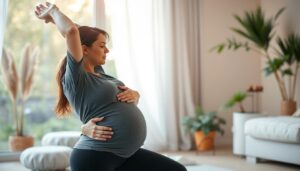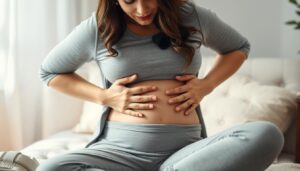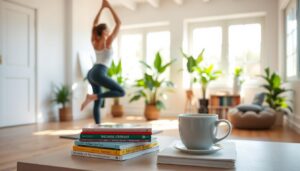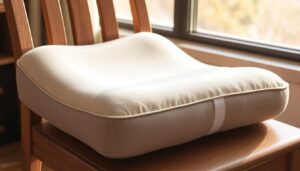When a woman is pregnant, her body changes a lot. These changes can make her back hurt. Giving birth makes the pain even worse for many new moms.
It’s very important for new moms to find ways to stop this pain. They need to take care of themselves and their babies. Luckily, there are many ways to ease this pain at home.
Key Takeaways
- Understanding the causes of postpartum back pain
- Importance of postpartum care for new mothers
- Simple methods for relieving back pain at home
- Tips for supporting new mom recovery
- Effective ways to manage postpartum discomfort
Understanding Postpartum Back Pain
After childbirth, many women feel back pain. This is because of physical and hormonal changes. Studies show up to twenty percent of women have this pain for three to six months.
Common Causes of Back Pain After Childbirth
There are a few reasons for postpartum back pain. Physical strain from labor and delivery is one. Another is the changes in how we stand during pregnancy.
Physical Strain During Labor and Delivery
Labor and delivery are hard on the body. They make the back muscles work very hard.
Postural Changes During Pregnancy
Pregnancy makes our body stand differently. This can put strain on the back.
How Pregnancy Changes Your Body’s Mechanics
Pregnancy changes how our body works. It moves the center of gravity forward. This makes the spine curve more, putting strain on the lower back.
- Increased lumbar lordosis
- Relaxation of ligaments and joints
- Shift in center of gravity
Timeline for Normal Recovery
How long it takes to feel better from back pain varies. For some, it might take a few weeks or months.
Why New Mothers Experience Back Pain
Postpartum back pain is common. It’s caused by hormonal changes, weight shifts, and how we stand. New moms often deal with all these, leading to pain and discomfort.
Hormonal Influences on Joint Stability
Hormonal changes during pregnancy affect back pain. The hormone relaxin makes joints and ligaments loose. This impacts the pelvis and spine’s stability.
The Role of Relaxin
Relaxin is a hormone that relaxes pelvic muscles and ligaments during pregnancy. It helps prepare the body for childbirth. But, it can also cause joint instability and back pain after birth.
Hormonal Timeline After Birth
After giving birth, relaxin and other pregnancy hormones decrease. But, their effects on joints can still cause back pain in new moms.
Weight Distribution Changes
Pregnancy weight, especially around the belly, changes where our body’s center of gravity is. This can put strain on our back muscles, causing pain.
Postural Adaptations During Childcare
Looking after a newborn means bending, lifting, and feeding a lot. This can strain our backs. Ergonomic relief like proper lifting and using pillows can help ease this strain.
| Factor | Effect on Back Pain |
|---|---|
| Hormonal Changes | Increased joint instability |
| Weight Distribution | Strains back muscles |
| Postural Adaptations | Leads to back strain during childcare activities |
Knowing these factors helps new moms prevent back pain. They can find postpartum back pain tips to manage their discomfort.
Identifying Different Types of Postpartum Back Pain
It’s important to know the different kinds of back pain after having a baby. Back pain can show up in many ways, hitting different spots.
Lower Back Pain Patterns
New moms often feel pain in their lower back. This pain can feel like a dull ache or a sharp stab. Things like lifting the baby or bending can make it worse.
Upper Back and Neck Tension
Poor posture while feeding or carrying the baby can lead to tension in the upper back and neck. This pain might feel like a strain or stiffness.
Sacroiliac Joint Pain Symptoms
Sacroiliac (SI) joint pain can cause discomfort in the lower back and buttocks.
“SI joint dysfunction can radiate pain down the legs, making it challenging to identify the source.”
Distinguishing SI Joint Pain from Other Types

SI joint pain is often mixed up with lower back pain. But, it usually hurts on one side of the lower back and buttocks.
Knowing the exact type of back pain is key to finding relief. By understanding each type, new moms can start to feel better.
Essential Postpartum Back Pain Tips for Immediate Relief
Many new moms face back pain after having a baby. There are ways to feel better at home. The time after having a baby can be tough, with back pain being a big worry.
Heat and Cold Therapy Applications
Using heat or cold can help with back pain. Both methods work well, depending on the pain type.
When to Use Heat vs. Cold
Heat therapy is good for long-term pain. It relaxes muscles and boosts blood flow. Cold therapy is better for sudden pain. It cuts down inflammation and dulls pain.
Safe Application Methods
Always put a towel between your skin and the pack. This prevents burns or frostbite. Use it for 15-20 minutes, then take a 30-minute break.
Proper Rest Positions
Resting right can ease back pain. Lie on your back with knees bent and feet flat. A pillow under your knees also helps.
Simple Stretches for Instant Relief
Doing gentle stretches can help right away. Try pelvic tilts, knee to chest, and cat-cow stretches. These stretches relax muscles and boost flexibility.
Adding these tips to your daily life can help a lot. New moms can feel better and handle the postpartum period easier.
Creating an Ergonomic Nursing Station
An ergonomic nursing station helps with postpartum back pain. It makes sure new moms sit right while feeding and caring for their babies.
Optimal Chair Selection and Positioning
Finding the right chair is key. It should support the lower back and adjust in height. This way, the mom’s feet stay flat or on a footrest, with knees at or below hip level.
Using Supportive Pillows Effectively
Supportive pillows make feeding more comfy.
Positioning for Breastfeeding
Pillows help support the baby during breastfeeding. This lessens the strain on the mom’s back and shoulders.
Positioning for Bottle Feeding
For bottle feeding, pillows also help. They keep the baby in the right spot, letting the mom stay comfy.
Foot Support Considerations
Foot support is vital for good posture and less back pain. A footrest keeps feet up and supported.
| Ergonomic Feature | Benefit |
|---|---|
| Lumbar Support Chair | Reduces strain on lower back |
| Supportive Pillows | Enhances comfort during feeding |
| Footrest | Promotes good posture and reduces back strain |
Proper Body Mechanics for New Mothers
Proper body mechanics are key for new moms to avoid back pain after having a baby. Using the right ways to lift, carry, and care for their baby helps a lot. This way, they can lower the chance of back pain.
Lifting and Carrying Your Baby Safely
Lifting and carrying the baby can hurt the back if not done right. New moms should bend at the knees and keep the baby close. They should lift with their leg muscles, not their back.
Car Seat Handling Techniques
It’s important to use both hands when handling car seats. Keep the seat close to your body to avoid twisting and straining your back. Make sure the car seat is at a comfortable height to avoid lifting too much.
Transferring Baby Between Surfaces
When moving the baby from one place to another, slide them instead of lifting. Or, use a transfer board if needed. This helps avoid back strain.

Diaper Changing Ergonomics
Diaper changing can hurt the back if the changing table is too high. Adjust the table so you don’t have to bend over. This helps reduce back strain.
| Task | Proper Technique | Benefit |
|---|---|---|
| Lifting Baby | Bend knees, lift with legs | Reduces back strain |
| Diaper Changing | Adjust table height | Prevents bending |
| Bathing Baby | Use supportive bath seat | Reduces lifting strain |
Bathing Your Baby Without Back Strain
Bathing the baby can be easier with a supportive bath seat. Keep the bathing area organized. Avoid bending or reaching too much during bath time.
By using these body mechanics tips, new moms can lower their risk of back pain. They can have a healthier recovery after having a baby.
Gentle Postpartum Exercises for Back Strengthening
Strengthening the back with gentle exercises is safe and works well. New moms can follow a routine that helps their core, pelvic floor, and builds strength.
Core Rehabilitation Basics
Core rehab is key for new moms, especially with diastasis recti. This is when the belly muscles split. Gentle exercises help get the core strong again.
Diastasis Recti Awareness
Knowing about diastasis recti is the first step to healing. It’s important to notice signs and symptoms to start the right exercises.
Safe Core Activation
Safe core activation means using the transverse abdominis muscle right. It’s about deep breathing, gentle tilts, and special contractions.
- Deep breathing exercises
- Gentle pelvic tilts
- Transverse abdominis contractions
Pelvic Floor Exercises
Kegels are key for the muscles that hold the bladder, uterus, and bowels. They help with incontinence and make the core stronger.
Progressive Strength Building Sequence
A sequence of exercises builds strength slowly. It’s divided into weeks for a safe and effective plan.
Week 1-2 Exercises
In the first two weeks, do gentle exercises like:
| Exercise | Repetitions | Sets |
|---|---|---|
| Pelvic tilts | 10 | 3 |
| Modified planks | 5 | 2 |
Week 3-6 Exercises
For weeks 3-6, try harder exercises like:
| Exercise | Repetitions | Sets |
|---|---|---|
| Bridges | 15 | 3 |
| Wall squats | 10 | 3 |
Following a gentle exercise routine helps new moms strengthen their back. It relieves pain and boosts well-being.
Daily Stretching Routines to Alleviate Back Tension
Daily stretching is key to easing postpartum back pain. Simple stretches can help you feel better. They are easy to do, even when you’re busy with a new baby.
Morning Stretches for Prevention
Start your day with gentle stretches to avoid back pain. Try tilting your head, rolling your shoulders, and twisting your torso. These moves loosen tight muscles and get you ready for the day.
Evening Relaxation Stretches
In the evening, do stretches to relax and ease tension. Hamstring stretches and gentle yoga poses are great. They relax your muscles and help you sleep well.
Stretches You Can Do While Caring for Baby
Many stretches fit into your busy day with a baby. You can stretch while standing at the crib or sitting during feedings.
Stretches While Standing at Crib
At the crib, lift your legs and tap your toes. This keeps blood flowing and muscles relaxed. Also, arch your back and then straighten, doing this a few times.
While feeding, stretch your back and shoulders. Roll your shoulders and stretch your chest by leaning back on your hands.
Adding these stretches to your day can greatly help with ergonomic relief from back pain. Make sure to do them every day for the best results.
Supportive Products for Postpartum Back Relief
Postpartum back pain can be eased with the right products. These items help new moms feel better. They offer ergonomic relief and support during the postpartum period.
Postpartum Support Belts and Bands
Support belts and bands help the back and belly muscles. They keep the core stable and lessen back pain.
When to Wear Them
Wear these belts and bands when doing things that hurt your back. This includes lifting the baby or doing chores.
How to Choose the Right One
Look for comfort, adjustability, and support when picking a belt or band. Make sure it’s breathable and won’t irritate your skin.
| Product Feature | Description | Benefit |
|---|---|---|
| Adjustable Straps | Allows for customizable fit | Ensures comfort and support |
| Breathable Material | Prevents irritation and discomfort | Enhances wearability |
| Support Level | Offers varying levels of support | Caters to different needs |
Ergonomic Baby Carriers
Ergonomic baby carriers spread out the baby’s weight. This lessens strain on the mom’s back and shoulders. They help keep a healthy posture and can be worn in different ways.
Supportive Mattresses and Pillows
A good mattress and pillows can help with back pain. A medium-firm mattress and contour pillows keep the spine aligned. They reduce discomfort.

Using these supportive products daily can help new moms a lot. They can ease postpartum back pain and improve recovery.
Nutrition and Hydration for Backhydration
A well-nourished body and enough water are key for healing after having a baby. New moms can feel better by eating foods full of good nutrients and drinking plenty of water. This helps with back pain.
Anti-inflammatory Foods
Eating foods that fight inflammation can help heal. Omega-3 fatty acids in foods like salmon and walnuts are good for this. Also, berries and leafy greens are full of antioxidants that fight inflammation.
Calcium and Vitamin D Importance
Calcium and vitamin D are important for strong bones. This is especially true after having a baby. Foods like dairy, fortified plant milk, and leafy greens are rich in calcium. Vitamin D comes from sunlight, supplements, and some foods.
Hydration’s Role in Disc Health
Drinking enough water is key for healthy spinal discs. Not drinking enough can hurt the discs and make back pain worse. Drinking water helps keep the discs soft and healthy.
Daily Water Intake Guidelines
Most people should drink at least eight glasses of water a day. But, how much you need can change based on how active you are, where you live, and your health. Listen to your body and drink when you feel thirsty.
| Nutrient | Food Sources | Benefits |
|---|---|---|
| Omega-3 Fatty Acids | Salmon, Walnuts, Chia Seeds | Reduces inflammation |
| Calcium | Dairy, Leafy Greens, Fortified Plant Milk | Supports bone health |
| Vitamin D | Sunlight, Supplements, Fortified Foods | Aids calcium absorption |
As Dr. Sarah Johnson, a postpartum health specialist, says, “Eating right and staying hydrated are basic steps for healing after having a baby. They can really help with back pain.”
Self-Massage Techniques for Back Pain Relief
Self-massage can really help with back pain after having a baby. New moms often feel back pain because of the changes and stress from childbirth. It’s a simple and effective way to feel better.
Using Tennis Balls for Pressure Point Release
Using tennis balls is a great way to ease back pain. You can put a tennis ball against a wall or the floor. This helps to loosen tight muscles.
- Stand with your back against the wall and place the tennis ball between your back and the wall, targeting areas of tension.
- Lentily lean against the ball, applying pressure to release tight muscles.
- Move the ball to different areas to target various pressure points.
Foam Roller Exercises
Foam rollers are also good for self-massage. They help loosen tension in the back.
Lower Back Release
To work on the lower back, lie on the foam roller. Place it across your lower back. Slowly move up and down to massage the area.
Upper Back and Shoulder Blade Release
For the upper back, put the foam roller under your upper back and shoulders. Roll back and forth to massage the shoulder blades.
Partner-Assisted Massage Techniques
Getting help from a partner can also help with back pain. A partner can reach areas you can’t.
| Technique | Description | Benefit |
|---|---|---|
| Tennis Ball Massage | Using tennis balls against a wall or floor to apply pressure. | Relieves muscle tension in the back. |
| Foam Roller Massage | Rolling on a foam roller to release tension across larger areas. | Effective for both lower and upper back relief. |
| Partner-Assisted Massage | A partner applies massage techniques to hard-to-reach areas. | Provides comprehensive back pain relief. |
Adding these self-massage methods to your daily routine can help a lot. Whether it’s tennis balls, foam rollers, or a partner, these options can help manage back pain.
Creating a Back-Friendly Home Environment
Making your home comfy and ergonomic helps with postpartum back pain. New moms can feel better by making small changes.
Organizing Baby Supplies for Easy Access
Organizing baby stuff is key. Keep it where you don’t have to bend or stretch. Store things at waist level.

Adjusting Furniture Heights
Changing furniture heights helps too. Make sure changing tables and cribs are easy to use. This cuts down on back pain.
Minimizing Unnecessary Bending and Reaching
Try to avoid bending and stretching. Rearrange your home to make things easier to get to.
Strategic Placement of Frequently Used Items
Put diapers, toys, and clothes where you can easily get them. This helps a lot. It gives ergonomic relief to new moms.
With these changes, new moms can make their homes better for postpartum recovery. It helps reduce back pain.
When to Seek Professional Help
New moms need to know when to get help for back pain. Some back pain can be fixed at home. But, some cases need a doctor.
Warning Signs of Serious Conditions
Severe back pain might mean a serious problem. Look out for signs like:
- Very bad pain
- Numbness or weakness in legs
- Hard time controlling bladder or bowel
Get help right away if you see these signs.
Types of Healthcare Providers to Consult
Many doctors can help with back pain after having a baby. Here are some:
- Primary care doctors
- Obstetricians and gynecologists
- Physical therapists
- Chiropractors
Physical Therapists Specializing in Postpartum Care
Physical therapists can make a plan to make your back stronger. They help with exercises and posture.
Chiropractors with Prenatal/Postpartum Training
Chiropractors can help with spinal manipulation. They use special techniques to ease back pain.
What to Expect at Your Appointment
At your first visit, doctors will check you out. They’ll ask about your health and do a physical check. They might do tests too. Then, they’ll make a plan just for you.
Integrating Back Care into Your Daily Routine
For new moms, it’s important to add back care to their daily life. This helps prevent and treat back pain after having a baby. It means making smart choices about what they do every day.
Creating Sustainable Habits
Building lasting habits is key to handling back pain. This includes gentle exercises and proper posture. Even small changes, like stretching often, can help a lot.
Balancing Baby Care and Self-Care
New moms often put their baby’s needs first. But, it’s important to take care of themselves too. Asking for help and accepting support from loved ones can ease the load.
Finding Time for Recovery
It can be hard to find time to rest, but it’s doable. Even a short break can be helpful.
Asking for and Accepting Help
It’s okay to ask for help. It shows you’re strong, not weak. Having a support system can lessen stress and back pain.
Tracking Your Progress and Adjusting Your Approach
It’s important to watch how you’re doing and change if needed. Keeping a journal of your activities and pain can show patterns. This helps you know what to improve.
By adding back care to their daily life, new moms can manage back pain better. This helps them recover faster and feel better overall.
Conclusion
Many new moms face back pain after having a baby. To feel better, they need to use the right techniques and take care of themselves. By following postpartum back pain tips, moms can ease their pain and help their bodies heal.
It’s important to make a comfy space for nursing and using tools like support belts. Also, moving right when caring for the baby helps. Going to doctor visits helps find and fix any pain causes.
Doing gentle exercises, stretching every day, and eating well helps too. Taking care of yourself and making smart choices helps avoid pain later. This way, moms can feel better and recover well.
FAQ
What are the most common causes of postpartum back pain?
How long does it take to recover from postpartum back pain?
Recovery times vary, but most women feel better in a few months. With the right care, like exercises and stretches, many women can manage their pain.
What are some simple stretches that can help alleviate postpartum back pain?
Simple stretches like pelvic tilts and knee to chest stretches can help. Morning and evening stretches are good too. Doing stretches while caring for your baby is helpful.
How can I create an ergonomic nursing station to reduce back pain?
Choose a comfy chair and use pillows for support. Foot support is important too. Adjust your nursing pillow and use a breastfeeding support to ease back strain.
What are some supportive products that can help alleviate postpartum back pain?
Products like support belts and ergonomic carriers can help. So can supportive mattresses and pillows. These items offer extra support and stability.
How can nutrition and hydration impact postpartum back pain?
Eating right and staying hydrated are key for recovery. Foods that fight inflammation and calcium are good. Vitamin D and water help too. INFLAMMATION Definition & Meaning – Merriam-Webster
When should I seek professional help for postpartum back pain?
If your pain is severe or doesn’t go away, get help. Look for numbness, tingling, or weakness in your legs. Also, if you have trouble with your bladder or bowels, seek help. If you’re not sure about your symptoms or if self-care isn’t working, talk to your doctor.
How can I integrate back care into my daily routine as a new mother?
Make self-care a priority. Create habits that support your back. Balance caring for your baby with activities that keep your back healthy.
Keep track of your progress and adjust as needed to stay healthy.
Related Posts
- Nursing Pillows That Protect Your Back
- Best Postpartum Recliners for Moms
- Postpartum Ergonomics for Moms Returning to Remote Work
- Best Pregnancy Pillows for Back Pain Relief
- How to Avoid Wrist Pain While Bottle Feeding
- The Ultimate Guide to Pregnancy Ergonomics: How to Stay Comfortable and Supported
- Top 5 Ergonomic Strollers for Active Moms
- How to Carry Your Baby Without Hurting Your Back







